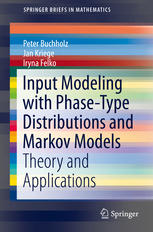

Most ebook files are in PDF format, so you can easily read them using various software such as Foxit Reader or directly on the Google Chrome browser.
Some ebook files are released by publishers in other formats such as .awz, .mobi, .epub, .fb2, etc. You may need to install specific software to read these formats on mobile/PC, such as Calibre.
Please read the tutorial at this link: https://ebookbell.com/faq
We offer FREE conversion to the popular formats you request; however, this may take some time. Therefore, right after payment, please email us, and we will try to provide the service as quickly as possible.
For some exceptional file formats or broken links (if any), please refrain from opening any disputes. Instead, email us first, and we will try to assist within a maximum of 6 hours.
EbookBell Team

0.0
0 reviewsContaining a summary of several recent results on Markov-based input modeling in a coherent notation, this book introduces and compares algorithms for parameter fitting and gives an overview of available software tools in the area. Due to progress made in recent years with respect to new algorithms to generate PH distributions and Markovian arrival processes from measured data, the models outlined are useful alternatives to other distributions or stochastic processes used for input modeling. Graduate students and researchers in applied probability, operations research and computer science along with practitioners using simulation or analytical models for performance analysis and capacity planning will find the unified notation and up-to-date results presented useful. Input modeling is the key step in model based system analysis to adequately describe the load of a system using stochastic models.
The goal of input modeling is to find a stochastic model to describe a sequence of measurements from a real system to model for example the inter-arrival times of packets in a computer network or failure times of components in a manufacturing plant. Typical application areas are performance and dependability analysis of computer systems, communication networks, logistics or manufacturing systems but also the analysis of biological or chemical reaction networks and similar problems. Often the measured values have a high variability and are correlated. It’s been known for a long time that Markov based models like phase type distributions or Markovian arrival processes are very general and allow one to capture even complex behaviors. However, the parameterization of these models results often in a complex and non-linear optimization problem. Only recently, several new results about the modeling capabilities of Markov based models and algorithms to fit the parameters of those models have been published.